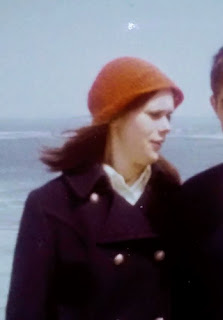Moving into the Dark...
At this time of year, yarnists often start moving away from the bright and the pale colors of the warm months and begin projects with the deeper, darker colors of fall and then winter. These rich, dark colors reflect the shorter, colder days to come, as we begin cocooning indoors, cozy with steaming cups of coffee and tea, crocheting to both provide warmth to others and to keep warm ourselves.
But working with these darker colors presents a challenge for the eyes, so special techniques are necessary. Working with black yarn presents the biggest challenge of all, so I usually don't recommend it to beginning crochet students.
First of all, it's good to work over a white tabletop; if you don't have one, try working over white poster board, or even a white towel on your lap. Then a good light source is needed. Use your brightest lamp, or try using an Ottlite; I purchased an Ottlite lamp many years ago to help with sewing, and it wasn't long before I began using it for crochet as well. The Ottlite bulb is specially designed to help with seeing details very, very well. I have a desk lamp Ottlite, but there are many models to choose from. Your eyes will thank you!
Also regarding lighting -- a friend bought me a neck lamp last Christmas, and it's terrific for focusing bright light directly onto your work; several of my students have purchased these as well. Neck lamps are inexpensive and most often rechargeable; a great buy! I use mine frequently for detail work and darker yarns. I am told crocheters and knitters also use headlamps as an excellent lighting source. There are also lighted crochet hooks, which you may find useful, but I have not found them as effective as neck lighting, in particular.
Lighting aside, using a simple stitch pattern is also best with darker yarns. Sometimes, even with the best lighting, finding the right loop for hook insertion can be difficult and sometimes it becomes a matter of stitching by feel rather than by sight. Take your time and proceed carefully. I would also add that if a yarn is too frustratingly difficult to see no matter what the stitch pattern, a simple Tunisian crochet stitch can be the way to go since this stitch can be done almost entirely by feel. Tunisian crochet will be covered in a future class.
So we may be moving into the dark time of the year, but there are ways to cope, and we crochet on!
But working with these darker colors presents a challenge for the eyes, so special techniques are necessary. Working with black yarn presents the biggest challenge of all, so I usually don't recommend it to beginning crochet students.
First of all, it's good to work over a white tabletop; if you don't have one, try working over white poster board, or even a white towel on your lap. Then a good light source is needed. Use your brightest lamp, or try using an Ottlite; I purchased an Ottlite lamp many years ago to help with sewing, and it wasn't long before I began using it for crochet as well. The Ottlite bulb is specially designed to help with seeing details very, very well. I have a desk lamp Ottlite, but there are many models to choose from. Your eyes will thank you!
Also regarding lighting -- a friend bought me a neck lamp last Christmas, and it's terrific for focusing bright light directly onto your work; several of my students have purchased these as well. Neck lamps are inexpensive and most often rechargeable; a great buy! I use mine frequently for detail work and darker yarns. I am told crocheters and knitters also use headlamps as an excellent lighting source. There are also lighted crochet hooks, which you may find useful, but I have not found them as effective as neck lighting, in particular.
Lighting aside, using a simple stitch pattern is also best with darker yarns. Sometimes, even with the best lighting, finding the right loop for hook insertion can be difficult and sometimes it becomes a matter of stitching by feel rather than by sight. Take your time and proceed carefully. I would also add that if a yarn is too frustratingly difficult to see no matter what the stitch pattern, a simple Tunisian crochet stitch can be the way to go since this stitch can be done almost entirely by feel. Tunisian crochet will be covered in a future class.
So we may be moving into the dark time of the year, but there are ways to cope, and we crochet on!



Comments
Post a Comment